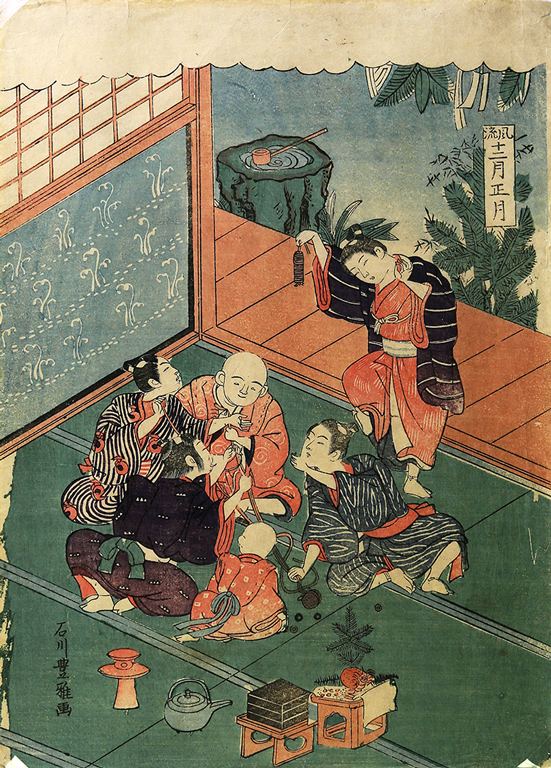
Japanese New Year, or Shōgatsu (正月), is a widely celebrated annual festival featuring numerous customs and traditions. Children receive otoshidama (お年玉), gifts of money in small decorated envelopes, from family friends and relatives; and families prepare special meals called osechi-ryōri (お節料理) in advance, as cooking during the first three days of the festival is considered to cause bad luck.[1] On New Year’s Day people gather at temples and shrines for a first visit called hatsumode (初詣).[2]They burn incense to create smoke that purifies the bodies and spirits of New Year visitors.[3] Many families celebrate by playing games, which are the subject of this print.
Popular games for the New Year include hanetsuki (羽根突き), or Japanese badminton, takoage (凧揚げ) or kite flying, and karuta (歌留多), which is a card game.[4] One board game called sugoroku (双六) was banned several times by the Japanese government due to people gambling while playing.[5]
This woodblock print was created for Fashionable Twelve Months, a series in which each of the twelve prints represents a scene from a different month. Ishikawa Toyomasa apprenticed under printer Ishikawa Toyonobu, who may have been his father.[6] Known for his prints depicting children, this example of Toyomasa’s work shows a family engaging in New Year’s festivities by playing a game. Today, alternative forms of entertainment mean that traditional New Year’s games are not played as frequently as they once were.[7]
-Mandy Prue, Class of 2016
Sources:
[1] “A Guide to New Year Traditions in Japan”, Japan Today, japantoday.com.[2] “New Year”, Japan Guide, japan-guide.com.
[3] “A Guide to New Year Traditions”
[4] Id.
[5] “Japanese Culture: New Year’s Games”, Transparent Language, blogs.transparent.com.
[6] “Online Collections: Ishikawa Toyomasa”, Portland Art Museum, portlandartmuseum.us.
[7] “New Year’s Games”
